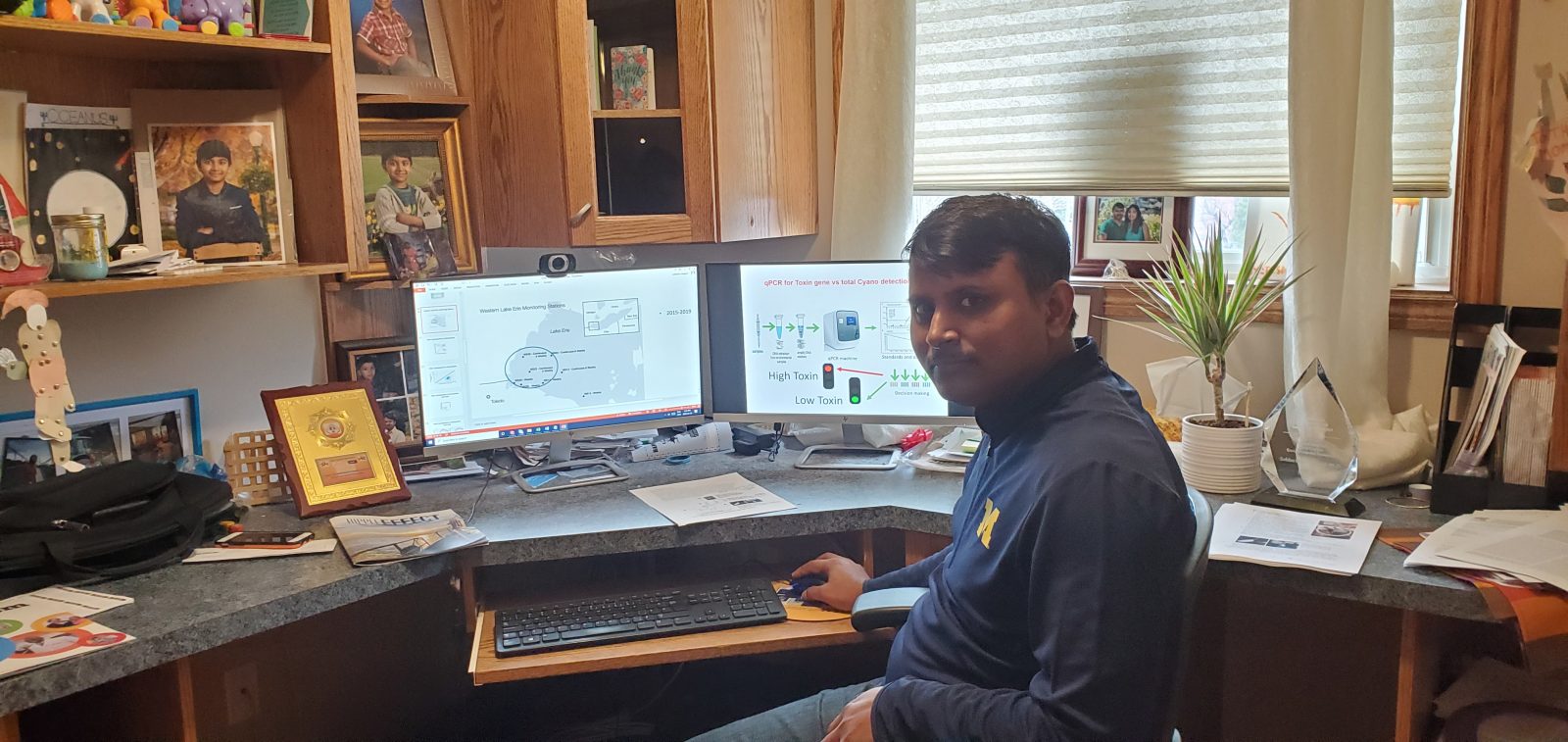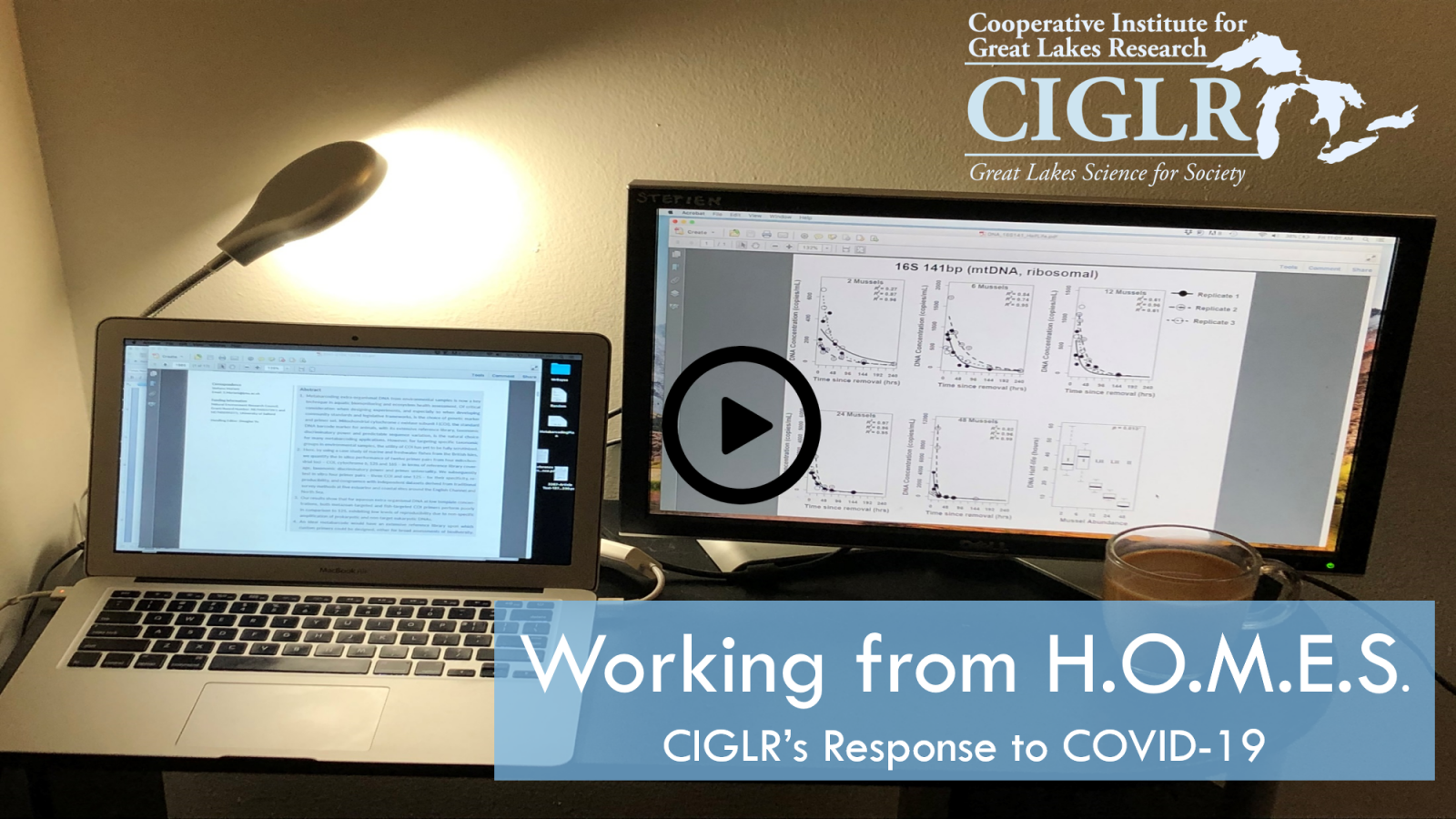Winter 2020 eNewsletter
CIGLR Spotlight
Working from H.O.M.E.S.: Great Lakes Research is Challenged but Carries On
All winter long, CIGLR scientists and our colleagues around the Great Lakes region are busy preparing for the spring and summer field season. Field monitoring equipment is fixed and readied for new deployments and the laboratories are ready for new experiments and sample analysis. However, this year is different. Labs and field stations remain quiet, university campuses are ghost towns. The Coronavirus Disease 2019 (COVID-19) has brought many unknown challenges to CIGLR and the Great Lakes community as whole.

CIGLR Assistant Research Scientist Dr. S. Rao Chaganti serves the Great Lakes from his home office as scientists around the world face research challenges related to COVID-19. Photo Credit: S. Rao Chaganti.
Although the daily hustle and bustle of laboratories and offices has ceased, the work and preparation for the 2020 Great Lakes field season carries on. It carries on from the kitchens, basements, sunrooms, living rooms, and home offices of the faithful scientists that work daily to turn their research into action and maintain safe and healthy Great Lakes communities. Hear from a few CIGLR employees about how they are working from home to maintain our H.O.M.E.S., our world’s most precious freshwater resource:
“It’s a difficult time as we work together to beat this global pandemic of the coronavirus. But, even as we practice social distancing
and telework to help stop the spread of COVID-19 all of CIGLR’s dedicated scientists and staff are working remotely in close collaboration with our partners at the NOAA Great Lakes Lab to make sure that important weather models, water level forecasts, and harmful algal bloom warning systems are maintained and updated regularly so that we can continue to protect people who live in
the Great Lakes. So, while all of us focus on the most important thing, which is to keep ourselves and our families healthy, you can rest assured that we remain laser-focused on keeping the Great Lakes healthy as well,” says Dr. Bradley Cardinale, CIGLR Director.
Dr. Subba Rao Chaganti, Assistant Research Scientist, says, “Hello Great Lakes community! COVID-19 has left many unknowns for our 2020 Great Lakes field season. And many other aspects of our daily research routine at CIGLR is unknown. Nonetheless, it did not stop us from working from home on the data collected from previous years and we are thrilled to bring another spectacular and exiting yearly update in our second annual magazine, Ripple Effect. Our institute has accomplished incredible progress in the past year on harmful algal blooms monitoring and forecasting through application of modern genomics tools. In addition to many other projects, we can’t wait to share our research impacts on the Great Lakes with you. Be sure to look for our new magazine this summer. Until then, stay tuned, be safe, and have fun!”
“In an effort to practice social distancing I will be stepping away from the laboratory and placing my focus on analyzing data that has already been generated, particularly data collected aboard an autonomous vehicle (3G-ESP). During deployments in Lake Erie’s western basin in August 2018 and 2019, the 3G-ESP collected physical samples of harmful algal blooms (HABs) for genomics, toxins, and water quality. Much of this data now requires sitting down at a computer to unravel its complexities which will ultimately expand our understanding of the new technology’s utility as well as the HABs biology sampled,” says Paul Den Uyl, Aquatic Ecology Research Technician.
Devin Gill, Stakeholder Engagement Specialist, says, “I’m proud of the progressive approach that the institute has taken toward social distancing. The health of the people in our community is just as important as the health of the Great Lakes. While teleworking, I’m taking steps toward protecting both. Our work to make Great Lakes water quality information easily accessible to the public continues…but now we’re meeting virtually!”
“For the past few months, the majority of my time has been spent in the laboratory collecting data for a variety of environmental genetic projects. Unfortunately, with the current events, my daily research routine has vastly changed and continues to evolve as new information comes in. In regards to my research, laboratory procedures have been put on hold for the time being, and this means I will have to delay further data collection. However, there is still much work that can continue outside of the lab and be completed remotely. I am analyzing data from my current projects and exploring ways to collaborate on future management efforts within our Great Lakes. Furthermore, I will be drafting research manuscripts, which is critical for all scientists to accurately and effectively communicate their findings to the public and scientific communities,” says Dr. Nate Marshall, Postdoctoral Research Fellow.
Joeseph Smith, General Programmer and Analyst, says, “Currently, I’m looking forward to another exciting year supporting fieldwork and analysis with data processing, plotting, and application development, both internally and externally facing. That is, of course, entirely dependent on how fieldwork plays out given the new reality. So we’ll see how it goes.”
“Currently, there are many unknowns regarding the future, our Great Lakes field season, and many other aspects of our daily research routine at CIGLR. However, we are excited to bring another beautiful, fun and exciting yearly update in our second Annual Magazine: Ripple Effect! Our institute has accomplished amazing work in the past year and we can’t wait to share our impacts and research with you! Be sure to look for our new magazine this summer!” says Aubrey Lashaway, Communications Specialist.
Christine Kitchens, Aquatic Ecology Research Technician, says, “As a lab technician, it’s challenging not being in the laboratory generating new data, but I’m taking advantage of my time away from the laboratory to process some data from my recent manganese analyses. Over the next few months, there will be several good papers and presentations about manganese flux and hypoxia in the central basin of Lake Erie to look forward to!”
“My research is about advancing forecast systems for lake ice in the Great Lakes and sea ice in the Arctic Ocean by using numerical ice and hydrodynamic models. We are facing a very uncertain situation for the future, posing challenges in navigating our daily research activities. We deeply thank the essential professionals at the high performance computing facilities at NOAA GLERL and the University of Michigan, which continue to deliver their services during this challenging situation. Thanks to them, we have continuous access to these computing facilities that keeps our modeling work going,” says Dr. Ayumi Fujisaki-Manome, Assistant Research Scientist.
Dr. Casey Godwin, Assistant Research Scientist, says, “During social distancing, I am working with an amazing team of CIGLR staff, students, and colleagues to finish analyzing our findings from the 2019 field season. We spent the last week pouring through our measurements and experiments from Lake Erie’s dead zone to learn how it impacts drinking water quality and nutrient cycling in the lake.”
“Like many, I have had to adjust my daily routine to ensure that I am keeping myself and others safe while continuing my work in light of the COVID-19 outbreak. While this abrupt change has had its challenges, I am grateful to be able to deliver pertinent science for the Great Lakes community while we all persevere through these troubling times. I look forward to getting back to business as usual and I hope everyone is staying healthy at home!” says Peter Alsip, Ecological Modeling Data Analyst.
Andrew Camilleri, Benthic Ecology Research Technician, says, “The COVID-19 outbreak has affected my ability to process benthic samples [samples collected from the lake bottom], but I am using this time away from the laboratory to analyze data from 2018. I am currently characterizing dreissenid mussel size distributions from Lakes Erie and Michigan, attempting to understand how mussel size changes with depth and lake region.”
“Although COVID-19 is adding many social stresses, my work is moving forward strongly. I am working on translating our harmful algal blooms (HABs) public opinion study into a manuscript. While personally experiencing the impacts of the pandemic, as a social scientist, I have many opportunities to reflect on the roles of scientific information in guiding people’s reactions to natural disasters and social disturbance. I’m interested to examine the public response to these environmental changes and to identify strategies to increase public capacity in discerning information. Outside of work (but inside my home), I continue my workout routine using dumbbells and a kettlebell,” says Dr. Tian Guo, Postdoctoral Research Fellow.
Mary Ogdahl, Program Manager, says, “During this difficult time, I feel so fortunate to be able to continue supporting CIGLR’s staff, research scientists, and partners much as I would in the office. Even though we are navigating uncharted waters, it is bringing me a lot of joy to reflect on our successes over the past year as I prepare our annual progress report to NOAA and work with our research scientists to prepare research proposals that will fund our work next year. I am also enjoying working with our ECO Team to find new and fun ways to reach Great Lakes communities virtually.”
CIGLR is thankful to continue our research from home and we look forward to serving our Great Lakes community in the field and in our labs as soon as we can. Stay safe and healthy out there!

